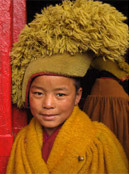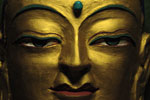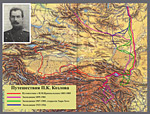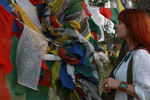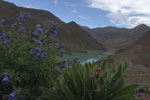Russian travellers in Ladakh
Ladakh has never been of much attraction to Russian travellers, because of its remoteness and difficulty of access from Russian territory. In the late 18th to early 20th centuries this mountainous country was visited by only a few individuals—Russian natives and non-Russians who had some dealings of a commercial or political nature with the Tsars. In this paper I will briefly discuss the Ladakh travels of these people.
One of the earliest travellers was probably Philip Efremov (1750 - after 1811). A resident of Viatka, he served in the Russian army with the rank of sergeant, his unit being stationed in Orenburg, on the south-eastern fringes of the empire. During the 1774 Pugachov peasant rebellion, the young soldier was taken a prisoner by a band of Cossacks and muzhiks. He managed to escape from his captors only to find himself in the hands of the Kirghiz tribesmen, who sold him to a Bokharian named Khoja Gafur. The latter offered him as a present to his father-in-law, Daniar-beg the ruler of Bokhara. Two years later, already in the service of this feudal lord as head of his harem, Efremov fled again. However, his road to his homeland turned out to be long and circuitous: via the Central Asian khanates Samarkand and Kokand; Kashgaria; Kashmir; on to India; thence by sea to London; and finally to St Petersburg where Efremov arrived safely in 1782.[1]
In the book about his nine year-long adventures and travels that Efremov later published in Russia (1786) one will find a rather detailed description of “Tibet, or Tevat” (a common appellation of Ladakh), the land he traversed on the way from Yarkand to Kashmir with a merchant’s caravan. However, as demonstrated later by the analysis of his narrative, the Tibet chapter was not actually written by Efremov but is a literal translation from German of an article published in 1783 by Johann Friedrich Hakman, a Russian academician of German extraction, in the journal Neue nordische Beytrage[2]. Be that as it may, the use of Hakman's material in Efremov's book does not discredit him as a visitor of Ladakh. The original version of Efremov’s travelogue dated 1784 includes an authentic, though much shorter, text from his own pen, arranged in two short sections: “Description of Tevat” and "Funeral customs in Tevat".[3]
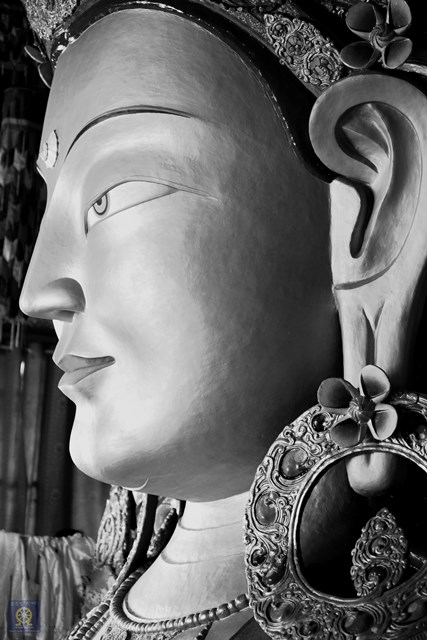
From these one could learn only a few facts about the Ladakhis, for example, that they live high in the mountains, wear a special sort of dress made of broadcloth and raw horse-skin sandals, and eat oat flour mixed with “tea water” (obviously a reference to tsampa). They also have a very peculiar funeral rite, described as follows. A lama carries a corpse on his back, covered by a black cloth. Another lama leads the corpse-carrier by a rope tied around his neck. A group of other lamas walks in front of them, chanting and playing various musical instruments. Having ascended a high mountain, they lay the dead body on the ground in a seated posture. Then they put firewood around it, pour oil on its head and finally cremate it. After the cremation the same lamas make a burial mound putting on top of it a clay column, white-washed with alabaster, one sazhen high (7 ft). Upon completion of the rite they proceed to the home of the deceased where “they drink and rejoice”.[4]
Another visitor to Ladakh was Rafail Danibegov (Rafiel Danibegashvili),[5] a Georgian by birth. A resident of Tbilisi, the capital of Georgia (Kartli-Kahetia kingdom) which by that time was already a vassal territory of Russia under the terms of the 1783 Georgievsk Treaty, Danibegov made two journeys to India, in 1795-1798 and in 1799-1813. Both of his journeys were prompted by political considerations. On his first trip he was to deliver presents from the Georgian ruler Heraclius II to Shamir-aga (Iakov Shahamirian), a well-to-do Armenian residing in Madras who secretly plotted for the unification of Georgia and Armenia into a common Christian state under Heraclius's auspices. Danibegov’s second journey which lasted for nearly 14 years was undertaken in the interests of the Russian crown. In the opinion of L.I. Maruashvili, Russia seized the opportunity of a Georgian merchant going to India to “ascertain the prospects for economic relations with a country with which the Russians had wanted to trade since the days of Athanasius Nikitin".[6]
Unfortunately, Danibegov's account combines his two journeys into a single narrative and provides no dates, so it is impossible to say when exactly he visited Ladakh. Most likely this occurred towards the end of his second voyage when he travelled from Pegu in Burma to Calcutta and then northwest across the Indo-Gangetic plain in the direction of Delhi and Kashmir. Danibegov reached Kashmir via Lahore and thence crossed into what he calls “a city of Tibet", which must be Leh. His description of the place is rather insipid and sketchy, like that of Efremov. What he finds worthy of mention about Ladakhis is that they practice polyandry when three or four brothers are married to one and the same woman—"a custom most evil and making no sense at all”; their only food is a boiled mixture of oat flour, milk and butter; and a large quantity of “soft goods", including wool (fleece) for making shawls, is regularly delivered by sheep caravans from Lhasa and then forwarded on from Ladakh to Kashmir. It took Danibegov 40 days to get from Leh (“Tibet”) to Yarkand in Kashgaria, the city surrounded by dense groves, which, in his words, “presents a rather lovely and comforting sight for a traveller”, as compared to the rugged landscape of Ladakh.[7]
Danibegov's journey finally ended in 1813 in Semipalat (today’s Semipalatinsk in the Kazakh Republic), then a fortress-city and a Russian outpost in Central Asia. He made his way from there to Moscow where two years later his travelogue was published in a Russian translation from Georgian under the title Puteshestvie v Indiiu gruzinskogo dvorianina Rafaila Danibegova (A Journey to India by a Georgian nobleman Rafail Danibegov). From the beginning of the 19th century, Tsarist Russia under Alexander I began to show a keen interest in distant Asian lands. This interest was generated largely by the desire to forge close economic and political ties with these countries, particularly India and the independent Himalayan princedoms, Kashmir and Ladakh, an aspiration that a few decades later would bring Russia into collision with another rapidly expanding super power, the British Empire. The main base for Russian penetration into Inner Asia was provided by the above-mentioned Semipalatinsk, the point of departure for Russian trade caravans to Persia, Bokhara, Afghanistan, Chinese Turkestan (Kashgaria) and northern India. The best known among pioneer Russian and Russia-connected caravan traders was Mehti Rafailov (Rafalla). A Jew from Kabul, he first worked as a prikazchik (merchant's clerk) of a thriving merchant Semion Madatov, and it was Rafailov who, as early as 1807, delivered directly to St Petersburg several bales of Kashmir shawls, a commodity then at the height of fashion with the Russian ladies’ beau monde. The event was immediately reported to the minister of foreign affairs Count N.P. Rumiantsev, who concurrently acted as a minister of commerce, and this prompted the enterprising Russian statesman to take the entire business under his control. Rafailov was encouraged to return to India with a quantity of Russian goods, given a special permit “for free travel both ways” and provided with a financial subsidy. So in February 1808 Aga Mehti set out for another Eastern journey, having Kashmir as his final destination.
When Rafailov returned to Semipalatinsk in 1811 he was interviewed by the military commander of the Siberian frontier, General Grigory Glazenap. Rafailov’s account of his trade mission was incorporated into Glazenap’s memorandum (zapiska) which was then forwarded to Rumiantsev. This had a separate section describing Ladakh—Tibetskoe vladenie (Tibetan State). Again, the description was laconic and uninspiring, similar to Efremov’s and Danibegov’s narratives. The Ladakhis were referred to as a race of generally “weak” and “almost exhausted” people, due to extremely unhealthy climatic conditions. Their capital city impressed Rafailov as “the poorest” settlement. Their only means of subsistence came from “the precious wool exported to Kashmir” and from the duties they collected from Indian, Kashmiri and Chinese merchants transiting their country.[8]
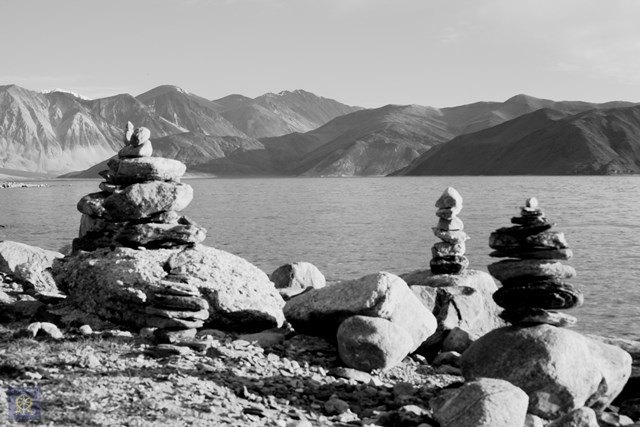
Rafailov travelled a few more times to Kashmir and India in subsequent years. In 1812 he came up with a “Project for Establishing Routes Leading from Russia to India” and submitted this to Rumiantsev. The document, like his earlier zapiska, provided various bits of information of a geographical, ethnographical and to some extent political character on the Asian countries and peoples that he had visited, namely, Bokharians (Muslim Tatars), Kirghiz-Kaisaks of the Middle Horde, Kalmyks and Tibetans (i.e. Ladakhis). Speaking of the latter, he again emphasized that Ladakhis were generally “ignorant and poor” people: all their well-being came mainly from the transit duties they collected and the “fine wool” they exported to Kashmiris for the manufacture of shawls and other cloths. Quite importantly, the Kabul trader drew Rumiantsev’s attention to the fact that the British, “having laid bonds on the larger part of India and her Shah, prepare now to enslave the rulers of Punjab, still retaining their independence”. Therefore Rafailov offered the minister his services to help him “establish intercourse and friendly relations, by means of correspondence, with the Sikhs, the Afghan Khan, the Marathas and the heirs of Tippo-Sahib themselves”.[9]
As a result, General Glazenap sent with Aga Mehti, in September 1813, a letter to the “Tibetan ruler” (i.e. the king of Ladakh), calling him by his official Muslim name Akbar Mahmud Khan and inviting him to enter into trade relations with the Russians.[10] The scheme worked out well. Rafailov safely reached Leh, presumably in early 1815. There he was welcomed by the king, who permitted him to conduct his trade operations unrestricted and free of duty, and promised to patronize Russian trade henceforth as much as he could. Moreover, the king handed the Kabul trader a letter for Glazenap, written in Persian, in which he expressed his willingness to open trade relations with Russia as well as his intention to dispatch his ambassador there.[11] Upon his return to Semipalatisnk Rafailov, submitted a new zapiska to the Russian government via Glazenap. In this he reported, inter alia, that the ruler of the Indian province and city of Lahore (i.e. Punjab) Radjitsin Badsha (Ranjit Singh) was seeking protection against the British who wanted to make him their vassal, “but he does not know where to find it”.[12]
Rafailov’s service to the Russians, which conveniently combined trade and diplomacy, proved fairly successful. He showed himself quite a skilful Great Gamer, having succeeded in forging a rather promising Russia-northern India link. In 1819 Mehti, already bearing the high rank of nadvornyi sovetnik (aulic councilor) in the Russian civil service, was sent to India again. This time he was charged with an important mission—to deliver several confidential letters from Russia’s new foreign minister Count K.V. Nesselrode to the rulers of Punjab, Kashmir and Ladakh (“an independent part of Tibet”). In these missives, all written on the same pattern, Nesselrode wrote that the Russian emperor, Alexander I, having learnt through Rafailov of the “glory, splendour and power” of these Indian rulers, as well as the hospitality they showed to visiting Russian merchants, enjoined him (Nesselrode) to “enter into friendly intercourse” with these three sovereigns via his “loyal and diligent officials” so
that both Russian and Indian merchants “could travel freely to their reciprocal regions”.[13] All these three letters were written in Persian, each placed in a little bag made of dark red patterned brocade.
In addition, Rafailov was commissioned with the task of procuring the six best Turkmen stallions for the state stud-farms as well as several Kashmir shegoats (actually pashm-yielding sheep) in Tibet for breeding purposes somewhere in Siberia. Mehti, however, argued that it would not be possible to bring the sheep to Russia as their export from Tibet was strictly prohibited by the local authorities. Also, as he pointed out in his memo to the Russian finance minister D.A. Guriev, the animals would not be able to endure the hardships of the long journey. Therefore he proposed to purchase the sheep’s softest fleece (used to make only the finest shawls, gathered after the animals shed their coats), an idea he promised to negotiate with “Tibet's ruler”. From this fleece the Russians could manufacture high quality Kashmir shawls at a special factory to be built in St Petersburg.[14]
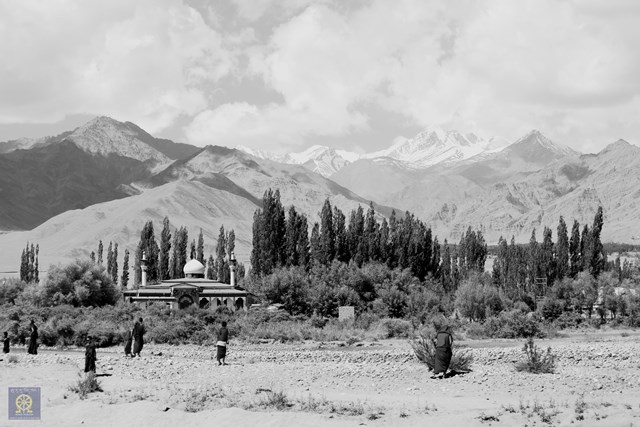
This plan was eventually approved by the finance minister who believed that its realization would bring Russia “incalculable benefits”. So on 30 April 1820 Rafailov set out from Semipalatisnk with his caravan accompanied by a strong Cossack convoy and headed for Chinese Turkestan. He reached this province unmolested and, having traded there for a while, moved southwards via Aksu and Yarkand to Leh. According to Russian sources, Rafailov fell ill during the journey and suddenly died. The Hungarian scholar Alexander Csoma de Koros who had travelled in these regions at that time, however, claimed that the Russian merchant was murdered by his followers in the Karakorum Mountains “in a pass several days journey from Leh”. His property was plundered and consequently “by some means” Nesselrode's letter to Ranjit Singh fell into the hands of the British traveller William Moorcroft. The latter employed Csoma to translate the dispatch for him and then communicated it to the British political agent in Delhi.[15]
Rafailov's journey to Ladakh in 1820 was actually Russia's last and abortive attempt at a rapprochement with that still independent Himalayan princedom. It took over five decades before more Russian travellers appeared in those troubled regions, at a time when the Anglo-Russian rivalry in Asia, the Great Game, had already reached its critical stage.
In the summer of 1875 Ladakh was visited by the well-known Russian war painter Vasilii V. Vereshchagin (1842-1904) and his wife, in the course of their three-month Himalayan journey. The couple crossed into the region from Kashmir and then followed the main caravan road between Dras and Leh. The Ladakhi capital did not impress them much: “The city of Leh makes a rather sorrowful sight, with a little Raja, who is powerless, since all power is in the hands of the [British] resident. His palace of dark stone is atop of the rock, and there is a temple nearby both structures being unimpressive”[16]. In Leh Vereshchagin easily made friends with the resident, Capt. Moloy, who turned out to be a good shot, like himself.[17]
During his journey the painter made numerous sketches of the terrain and of different types of people, with which he would later illustrate his travel account, and he also hunted regularly for animals, including the kiangs (wild asses). In the second volume of his book, one will find a long and very lively written chapter on Ladakh, which abounds in details relating to the Ladakhis' way of life and various natural history observations which exceed by far the laconic and rather unemotional descriptions by Efremov and Danibegov.
A year later, one of the leading Russian military geographers, retired Major- General M.I. Veniukov published a detailed description of the Aksu-Ladakh road via Yarkand in the Izvestia (Proceedings) of the Imperial Russian Geographical Society. This was based on a little known manuscript from the Orenburg Krai and West Siberia frontier archives, in particular one of the files of the Chief Administration of West Siberia entitled: “On Foreign Trade, 1824-1828”.[18] Veniukov's piece listed 49 intermediary stations between Aksu and “the town of Tubetu” in Ladakh (i.e. Leh), with information on the distance between stations and the availability of water, fuel and fodder. The length of the entire route was given as 1,328 versts. At the same time, Veniukov provided a valuable commentary on the list by comparing the places (stations) with those given on the maps of Western geographers, such as Klaproth’s map of Central Asia and Walker's map of Chinese Turkestan. “This is very accurate information, though it became available to science only fifty years later and not through us, but through the British”, wrote Veniukov in conclusion. “In those days [in the 18th - early 19th centuries] our chiefs had a common practice of collecting a great amount of material about neighbouring Asian countries, but they filed these as ‘state secrets’. No doubt Russia and world science have lost much because of this system, and the Aksu-Ladakh route provides a brilliant proof of this”.[19]
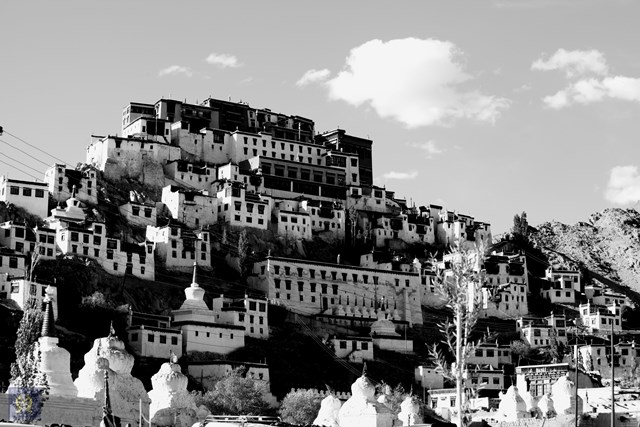
Another Russian traveler in the same period was Nikolai Alexandrovich Notovitch (1858 - some time after 1916). A journalist and author of several books of patriotic—Russophile—orientation,[20] Notovich is remembered today mainly as a person who claimed to have discovered in November 1887, in Hemis monastery in Ladakh, a manuscript of what he himself alleged to be a Tibetan Gospel of Christ. The find caused quite a sensation among ecclesiastical circles and the general public in western Europe and in Russia, in particular after the text had been published first in French, under the title La vie inconnue de Jesus-Christ (1894), and then in the German, English, and Russian languages.[21] In the opinion of a large section of academic scholarship, the published manuscript was nothing but a fraud or a ‘‘popular hoax”.[22]
Personally, Notovich had to pay a high price for his discovery, being imprisoned in the Peter-and-Paul Fortress in 1895 and later sent into exile to Siberia. The Soviet (Russian) Indologist L.V Mitrokhin suggests that Notovitch had got hold of some works by Christian missionaries, published in Tibetan and circulated in the Himalayas (Ladakh), which impressed him as writings by genuine Buddhist authors. However, these writings “do not lead us in any way to the text that he published under the heading of The Unknown Life of Holy Issa. Even if Notovitch had indeed used these Tibetan translations from the Bible, this only gave occasion to awaken his dormant literary abilities, having brought to life a work, which, although it is only a literary hoax, continues to this day to produce an almost magic charm on some Eastern and Western authors”.[23] This conclusion concurs with that of Norbert Klatt, whose research provided a basis for Mitrokhin’s own investigation.
There is no doubt that Notovitch did travel in Ladakh and Kashmir, as well as Punjab, at the end of 1887, yet the purpose of his journey remains obscure. The fact that it coincided chronologically with an attempt by the deposed Punjab ruler Dalip Singh (1838-1893), son of Ranjit Singh, to foment an anti-British, uprising in India with Russian military assistance suggests that his journey might have had a secret political dimension. We know that the maharaja came to Moscow in the spring of 1887 and he soon applied to the Russian emperor Alexander III offering his services, as well as those of other Indian princes, for the liberation of his countrymen “from the cruel British yoke” and calling upon the Tsar to adopt India as a Russian protectorate.[24] Another Russian who was intimately involved in this intrigue was Mikhail Nikiforovitch Katkov (1818-1887), a publisher of the Moskovskie Vedomosti (Moscow News) and Russkyi Vestnik (Moscow Chronicle), a good friend of H.P. Blavatsky who incidentally published her Caves and Jungles of Hindustan in the latter journal between 1879 and 1882.[25] The chief supporter of the maharaja in the Sikh community of Punjab was his cousin Thakar Singh Sandhanvalia. However both Thakar Singh and Katkov died in 1887 and the Tsar turned down Dulip Singh’s proposal, which eventually dashed the entire scheme.
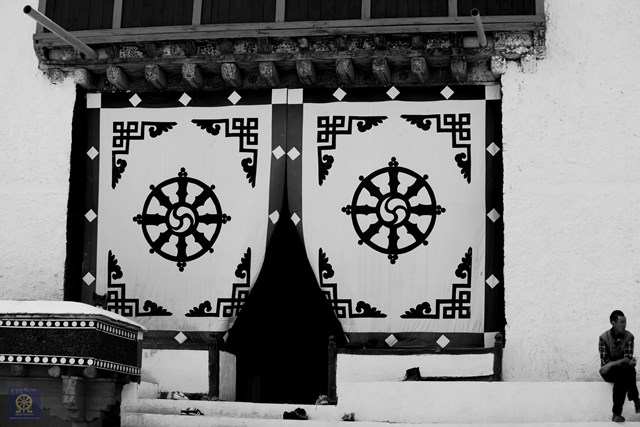
Whether Notovitch had anything to do with Dalip Singh’s plot is unknown. His travel diary provides very scanty information about Ladakh and his references to the people he met with during his journey in northern India are doubtful and unreliable in most cases.[26] In the late 19th and early 20th centuries, India was visited by several Russian agriculturalists, specialists in tea-growing, and some officers of the General Staff, such as Captain Novitsky, Staff-Captain Snesarev and Colonel Polozov, with the permission of the Anglo-Indian authorities. One of them (Novitsky), on his return trip to Russia, passed through Kashmir and Ladakh, and described these regions in some detail in the book he published shortly after the completion of his journey under the title Iz Indii v Ferganu (From India to Fergana).[27]
The Indian travels of Captain Vasily Fedorovich Novitsky (1869-1929) were organized in 1898 by the General Staff and the Imperial Russian Geographical Society and lasted for three months. He was commissioned to do some field research in India: to collect plants, minerals and insects, conduct meteorological observation and do some route surveys. More specifically, he was assigned the task of passing from India by a land route into Russian Turkestan. Basically, Novitsky’s trip was a typical reconnaissance expedition, in the course of which he had done a considerable amount of visual observation, instrumental measurement, collecting work, as well as photography. In the book, which he later published about his journey, readers can find a general description of Ladakh's nature—its mountains, vegetation and fauna, done in a very professional manner. There were also some curious ethnographic notes. For example, Novitsky remarked that Ladakhis were an “exceedingly dirty-looking people”—they never change their dress and wear it until it turns into “a heap of shreds”. Their braids “give shelter to entire colonies of insects, constantly tormenting their possessors”. At the same time, “a Ladakhi Tibetan is kind, honest and quite unselfish”. The Ladakhis’ family relations are dominated by polyandry, “when brothers have a common wife with whom they cohabit simultaneously”.
Novitsky also emphasized the piety of the Ladakhis. What surprised him most, were the “prayer machines” (prayer-mills) they rotated all the time. “What an amazing saving of time and human mental effort!”—exclaimed Novitsky. These prayer machines, in his words, made an “indispensable attribute” of every Buddhist monastery (gompa) in Ladakh. Talking of his everyday life, Novitsky complained about missing badly throughout his whole trip the traditional Russian tea (of Chinese make), usually drunk from a samovar (a “self-boiler”, with an interior heating tube to keep water at boiling-point for making tea). Unlike Russian tea, a drink which is “so palatable and thirst-quenching", the Lipton’s tea from Ceylon that he was supplied with “is unpalatable and makes a rather strong and bitter infusion”, like all Indian teas.
Novitsky's itinerary in Ladakh, as given in his book, led all across the country from the Kashmir border to the Karakorum Range, along the well-known track: Dras - the Indus - Kargil - Muibekh - Lamayuru - Saspul - Nimu - Leh. In Ladakh's capital Novitsky briefly met with his British counterpart, the political agent Captain Chevenix-Trench, who turned out to be a very amiable and friendly chap. He handed over to Novitsky a packet he had received for him by post from the Russian consul in Kashgar, N.F. Petrovsky, with a “Chinese passport” issued by the local taotai and a travel pass from the Russian consulate. The Briton also helped the Russian officer to find a guide to take him to Yarkand, a half-Tibetan, half-Muslim named Korban, who spoke no English but only Hindustani. Thus, on 24 June Novitsky finally left Ladakh for Kashgaria, via Shyok, Nubra and the Karakorum Pass, with a six-man caravan.[28] Initially, he had wanted to return to Russia via the Eastern Pamirs by the Gilgit route, but the latter was a no-go for foreign travellers, especially Russian ones. The British officials in Shimla told Novitsky that the Gilgit route was unsafe and suggested that he should take a safer road—from Kashmir via Ladakh to Kashgaria. So this was how Novitsky came to be in Ladakh, on a trip not really motivated or duly planned.
A few years later, in August 1907, when the Great Game was already drawing to a close, Ladakh was visited by two more Russian military officers, M.S. Andreyev and Captain P.A. Polovtsev (brother of A.A. Polovtsev, the Russian Consul General at Bombay). Again, as in Novitsky's case, they only transited the country on the way home after a rather lengthy stay in India, where they studied the local dialects and apparently collected all sorts of political and military information. In his report of his time in India (spent for the most part in Bombay), Andreyev devoted a few pages to his visit in Ladakh. In these he dwelt on Ladakh’s administration, commercial activities, and the way of life of the Ladakhis. According to him, Ladakh was ruled by the Kashmir governor “under the supervision of the British Joint Commissioner”, and there was only one Englishman in the country, residing in Leh, one Captain Campbell. Apart from him, there were several German missionaries belonging to the Moravian church, all stationed in Leh. One of these missionaries published a newspaper, “the only one in the Tibetan language”.[29]
Andreyev also reported that the population of Ladakh was badly stricken with famine, the responsibility for which he put on the British. This was because the local inhabitants were obliged to feed the trade caravans, passing from Yarkand and Khotan to Indian markets, for which reason they were heavily taxed in kind, according to the system introduced by the British. They had no access to the food stores which accumulated all the basic foodstuffs and sold these for money only to traders. Reviewing contemporary trade in Ladakh, Andreyev expressed the optimistic opinion that some of the popular Russian merchandise could easily find its way to the Ladakh markets, especially printed cotton (chintz) and “devil's skin” (a kind of cheap hard-wearing cotton fabric). Interestingly, on his return journey from Leh to the Russian frontier, Andreyev kept a diary in which he recorded the details of the road and he also conducted some hypsometric observations, to determine the altitudes of terrain, with the help of several barometers, thermometers and a boiler that he carried with him.[30]
Three years later, in 1910, Andreyev’s companion, Captain of the General Staff Polovtsev, made another trip to India. Like Novitsky, he also wanted to return to Russia across the Indo-Chinese border via Gilgit - Kilik -Tashkurgan. However, the British again strongly objected to his plan because of the strategic importance of the route leading through the north-western frontier regions of India.[31] So it seems that Polovtsev had to take the Leh - Karakorum - Yarkand route instead, to his own obvious disappointment and that of his superiors in the War Ministry.
In 1911, a three-man Russian zoological party under S.N. von Wick visited the Sind, Sulaiman Mountains, Punjab and western Kashmir where they conducted field research. A year later von Wick tried to mount another expedition to the north-western corner of India, with strong backing from the Russian Academy. However, this time he was unable to obtain permission from the British authorities. The Russian Consul General in Calcutta K.D. Nabokov relayed to St Petersburg the reply he had received from the assistant secretary of the Foreign Department in Delhi which stated the reason: “... His Majesty's Government consulted us the other day as to Mr. v Wick's proposed journey, and in reply we were forced to discourage it, as his itinerary is for the most part through disturbed areas where escorts would be necessary. It is most improbable that HM.'s Government will agree to the journey in the face of our reply. We are very sorry to have to pour cold water on the undertaking, but many of the places are such as our officers even are not permitted to visit without special sanction and arrangement”.[32]
Ladakh apparently became one of these restricted areas, judging by the above reply. However, in 1912, when the Russian Academy wanted to send another zoological expedition under A.N. Avinov and A.G. Yakobson to Northern India, including Sikkim, Quetta, western Kashmir, Ladakh and the Karakorum, it again faced strong opposition from both London and Delhi. The foreign secretary of the Government of India, Sir Henry McMahon confidentially informed the acting Russian Consul in Calcutta L.Kh. Revelioti that his government objected to Avinov’s scientific journey to Ladakh and Karakorum for several reasons. One of these was that his projected visit to Ladakh and to one of the passes leading from India to Turkestan would “entail great efforts and difficulties on behalf of the local Anglo-Indian authorities, and when their efforts and troubles are rewarded with a reprehensible, from their point of view, conduct of the ‘scientific travellers’, there is no reason to do any special favor for these travellers” (in Reveleoti's quotation). Obviously, this was a lame excuse as in his conversation with the Russian consul McMahon did not cite a single example of serious misconduct by Russian travellers. Still, Revelioti pressed hard Avinov’s case by saying that the person was not a casual traveller but a Kammer-Junker (gentleman of the Emperor’s bed chamber) and a member of the Russian Geographical Society, well-known for his works on entomology, and, on top of that, his (Revelioti's) personal guest. As a result, the British diplomat had to abandon his “ironical tone” and state that “in such a case he will not object to M. Avinov’s journey to Ladakh”, provided the Viceroy (Lord Harding) gave his consent to it. The latter did give his sanction after a few days. However, an arrangement was made that Avinov and Yakobson would be accompanied by an English officer, Captain Marsh. The latter was to join the Russians in Rawalpindi, yet his orders were cancelled by his superiors the next day.[33] It is not clear from the available Russian records whether the British provided a substitute for him, thus enabling the Russian team to carry out their project.
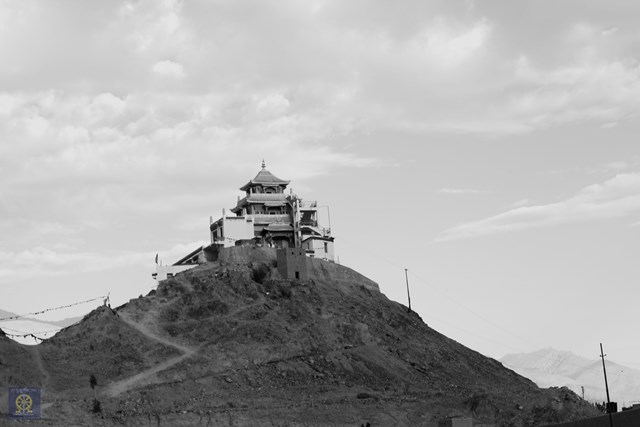
This episode clearly demonstrates that, despite the Anglo-Russian rapprochement heralded by the 1907 St Petersburg Accord, there still remained a great deal of mutual mistrust and misunderstanding on the part of both English and Russian officials, which made some of the areas along the northwestern and northern Indian frontier practically inaccessible for Russian travellers, including Ladakh, a country to which the Russian General Staff had never attached much strategic importance.
The 1917 Bolshevik revolution in Russia revived the seemingly outlived Ariglo- Russian rivalry throughout the whole of Asia to an unprecedented degree. India, the “stronghold” of British and hence “world imperialism”, immediately became a major target for subversive Bolshevk activities. Soviet leaders gave special attention to the “most revolutionary” Indian province of Bengal as well as Kashmir which occupied a key position in facilitating the importing of Bolshevik emissaries and propagandist literature via the Pamirs - Gilgit - Srinagar and Ferghana and the Kashgar - Yarkand - Leh routes. To prevent the entry of Bolshevik literature and agents into India from Soviet Central Asia, via Wakhan, and the frontiers of Kashmir, an additional police force was created by the British, and this was deployed at Ganderbal, Bandipora and Uttarmachipura—the gateways to Kashmir from Ladakh and Gilgit.[34]
Despite the fact that Commintern records were fully declassified in Russia in the 1990s, we still know very little of the Commintern’s subversive operations in the Kashmir/Ladakh area.[35] However, there is some evidence from other Russian sources. For example, in early 1919 the Russian Committee for the exploration of Middle and Eastern Asia (an entity affiliated with the Bolshevik Foreign Ministry, Narkomindel), came up with a proposal for a scientific expedition to India along the Kashgar - Yarkand - Kashmir route (sic.),[36] under one Bravin, nicknamed “Kenzhoga”.[37] No details of the projected “exploration” work to be carried out by Kenzhoga are given in the surviving papers of the Committee, which leaves room for suspicion about the purpose of this bogus expedition.
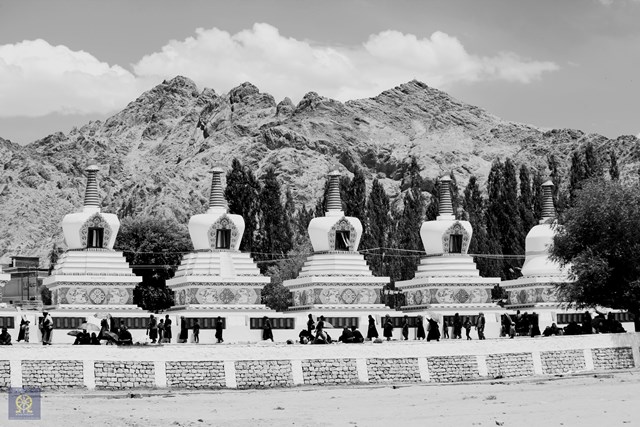
The most distinguished Russian traveler in Ladakh in the post-revolutionary period was undoubtedly Nicholas (Nikolai) Konstantinovitch Roerich (1874- 1947). A prolific painter, mystic and visionary, he emigrated from Russia shortly after the Bolshevik coup and in 1920 settled with his family, including his two sons, Yuri (George) and Sviatoslav, and wife Helen (Elena), in New York. There he engaged in active artistic and educational work, having founded several art institutions in 1921-23 (the Master Institute of United Arts, the “Corona Mundi” International Art Center and the Roerich Museum, all based in New York City). More importantly, in the same years Nicholas claimed to have entered into a mystical communication with the mahatmas, believed to make the White Brotherhood, a secret spiritual community somewhere in Tibet and the Himalayas, an idea he borrowed from Blavatsky. The contact was established in the course of spiritualistic seances, through his wife, believed to be a clairvoyant and a good medium, whereupon both Nicholas and Helen, following Blavatsky’s example, placed themselves under the superior guidance of these supra-human creatures. In 1923, acting on the "lofty instructions" (spiritualistic messages) of the mahatmas, the three Roerichs (Nicholas, Helen and Yuri) travelled to India, a journey which was undertaken as a part of their teachers' global “Great Plan”—to lay the foundations of the new world order, i.e. the “sixth human race”, as had been predicted in Blavatsky’s teachings.
The transformation of the world, in Roerich’s vision, was to begin with the advent of Lord Maitreya, the Buddha-to-come, alias Jesus Christ and ... Mahatma Morya, who was already dictating telepathically to Helen (since 1921) his New Age revelation, Agni Yoga, in the same way that he had earlier communicated the Secret Doctrine to Madame Blavatsky. In 1925, from Darjeeling, the Roerichs set out on a journey—a great mystical tour in search of the “signs” of the Coming Messiah and heading ultimately for Shambhala, to catch up with the mahatmas. To the outside world, the trip was presented as an “American scientific expedition”, having artistic and archeological purposes. The journey lasted for three and half years and encircled Central Asia, from Sikkim through Punjab, Kashmir, Ladakh, Karakorum, Khotan, Kashgar, Urumchi, Irtysh, Altai Mountains, Mongolia, the Central Gobi, Tsaidam, and finally Tibet.[38]
There was a special reason for the Roerich mission’s visit to Ladakh. Nicholas wanted to see the Tibetan Gospel, which he had learnt about from Notovich's book in late 1924. The Government of India granted Roerich permission for a period of a year, knowing of his anti-Bolshevik leanings, and gave his expedition all facilities. In the book Roerich would publish later about his Trans-Asiatic journey (Altai-Himalaya, 1929) his Ladakh journey was discussed in great detail, yet this was quite an unusual record. The three chapters devoted to Ladakh were filled with various legends, prophesies and simply bazaar rumours relating to the impending Maitreya’s coming. Roerich mentioned one by one all the monasteries he visited in Mulbekh, Lamayura, Saspul and Sheh only to tell the reader that he found there “the great images” of Maitreya. “Beyond Dras we encounter the first Buddhist message. Near the road are two stone stelae representing Maitreya. Nearby, a stone with the image of a rider. Is this rider not upon a white horse? Is this not a message of the new world? It is remarkable that this first Buddhist emblem happens to be just the image of Maltreya”.[39] Roerich gave special attention to Leh because “here the legends connected the paths of Buddha and Christ: Buddha went through Leh northwards, Issa communed here with the people on his way from Tibet”.[40] However, Roerich was unable to find the manuscript of the Tibetan Gospel in Hemis, judging by his own account. He only suggested that “these manuscripts” (the Tibetan Gospel and a book about Shambhala) are hidden somewhere—they “lie in the darkest place”, “out of sight", and are “probably feeding the mice”.[41] To the Russian reader in the original Russian version of the same book (first published in the USSR in 1974) he would tell quite a different story: “... We have learnt about the authenticity of the manuscript about Issa. In Hemis, indeed lies an old Tibetan translation from the manuscript, written in Pali and preserved in a well-known monastery near Lhasa. ... Tales about forgery are exploded”.[42]
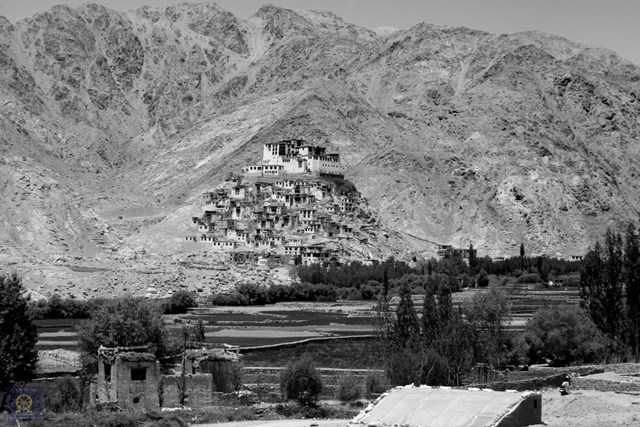
In the English version of Altai-Himalaya, Roerich quoted abundantly from two manuscripts—the one published by Notovitch, but without acknowledging his source, and another one, speaking of Christ’s sojourn in Ladakh. This allowed some later Soviet authors, especially from the circle of Roerich’s sympathizers, to jump to the conclusion that he had indeed held in his hands an unknown copy of the Tibetan apocrypha, the one that Notovitch saw in 1887. Even more, they believe that he discovered in Hemis a new text, which specifically dealt with Christ's preaching in Ladakh (which was in fact the legend Roerich quoted in the English version). To give more weight to this claim one of these authors, E. Lazarev, referred to a well-known Soviet Indologist and Roerich disciple, L.V. Shaposhnikova who had told him in a private interview that in 1979, while in Hemis, she too saw a manuscript of the Tibetan Gospel (sic.). However, “lack of time" prevented her from copying or translating the text.[43]
Commenting on Shaposhnikova's sensational claim, another Soviet Indologist L.V. Mitrokhin, expressed great surprise that his colleague found no time to copy even one page of the “mysterious manuscript” and did not even disclose to her interviewer how she had located it in the monastic library. Mitrokhin also regretted that both Lazarev and Shaposhnikova were apparently unaware of N. Roerich's strong denial of the discovery of “a manuscript from Christ's times attributed to him”, an opinion he expressed in an article published as late as 1941. Curiously in the same piece. N.Roerich also remarked that “in the long run” we must be thankful to those telling stories about his discovery because by doing so the storytellers attract our attention to the “treasures of the spirit”.[44]
During his time in Leh, Roerich met with the members of the Moravian mission who agreed to rent him one of their houses “on condition that I sign an agreement to do no religious, semi-religious, etc. propaganda”.[45]This rather strange demand on the part of the missionaries has an explanation. While passing through Ladakh and Kashmir, Roerich named himself Mahatma Ak-Dorje and circulated everywhere Tibetan leaflets saying “Maitreya is coming”. In Spiti alone, he distributed among the local inhabitants about a hundred such leaflets.[46] The purpose of this hoax was obviously to spread word of the roaming messengers from the Northern Shambhala, i.e. the Roerichs. Along with these leaflets Roerich also circulated—in Ladakh, Kashmir and Chinese Turkestan—his own prophesies about an appearance in the near future, in the year 1928, of “the messengers of the warriors of Northern Shambhala”. The Asiatics were called upon to welcome these people and “accept the new glory of Tibet and Mongolia”. Moreover, Roerich told the lamas in the monasteries he visited—and possibly also the king of Ladakh who hosted him in his palace—of the necessity of forming a union with the Soviet Russian Republic, for only Russia could apprehend and support their feelings and aspirations. He also told of the need to “purify”, i.e. reform, the present-day Buddhist teachings in order to revive the ancient-pure-precepts of the Buddha Shakyamuni, which were perfectly in line with Communist doctrine.
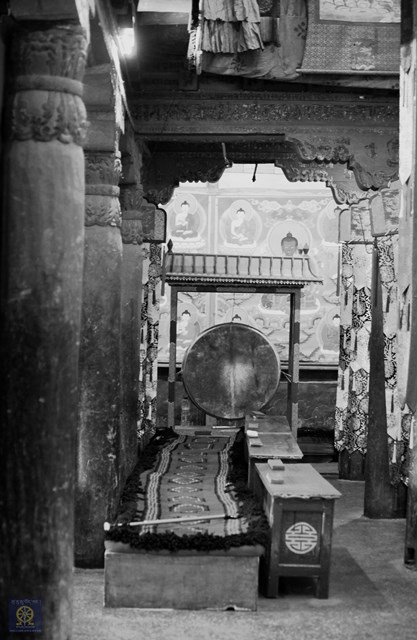
These and other intriguing details relating to Roerich’s Central Asian expedition became known to scholars only recently. They demonstrate clearly that Roerich was engaged in extensive pro-Soviet propaganda in the course of his much publicized journey. And in 1926, during his, three-week visit to Moscow on the way to Altai, he even offered the Soviet leaders a 10-point plan for a Buddhist revolution in Asia accompanied by a letter from the mahatmas (members of a secret Himalayan Maitreya Sangha), who explicitly voiced their support of the Bolshevik regime. The Soviets however declined the proposal, not willing to place themselves under the “reign supreme” of the mahatmas although, strange as it may seem, they verbally acknowledged their existence.[45]
Apart from Nicholas Roerich, his son George, who was later to become an eminent Oriental scholar, wrote his own book about the journey, in which he had participated, under the title Trails to Inmost Asia (Yale University Press, 1931). This included a rather lively description of Ladakh, showing his keen interest in the country's historical past and antiquities, an account much more sober and academically sound than that of his father. In 1950, he published a short article Ladakh, which was a summary of Ladakh's cultural history from the 9th to the 19th centuries.[46] There were probably more emigre Russian travelers in Kashmir and Ladakh in the period under discussion, such as, for example, Irma de Manziarli.[47] A theosophist and a close friend of the young J. Krishnamurti, she, together with her children, travelled in India in the mid-1920s, concurrently with the Roerichs. Yet her travel account is of little interest to students of Ladakh.[48]
Epilogue
Since the 1990s, following the collapse of the USSR, India has become a real Mecca for Russian tourists, particularly yoga practitioners and Buddhists. They are particularly attracted to places like Goa and Dharamsala, as well as other popular cultural and historical sights, but not Ladakh. This is easy to explain: Ladakh is practically unknown to them. On the other hand, Russian scholars—mainly those engaged in Indian studies—have begun to show some interest in the region, marginal though it is as compared to mainstream scholarship focusing on India and Indo-Russian relations. Thus, in 1995 A.A. Vigasin and S.G. Karpiuk republished Efremov’s travel account in their Puteshestvia po Vostoku v epokhu Ekateriny II, and a few years later Vostochnaia Literatura, an academic publishing firm in Moscow, brought out a huge collection of miscellaneous archival material in the two-volume Indiisko-Russkie Otnoshenia (Indo-Russian Relations, 1997-1999). These are mainly documents extracted from the diplomatic archive (AVPRI) which shed some light on the few and little-known Russian travelers in Ladakh in the 19th and early 20th centuries. This scholarly interest in Ladakh may grow in the future provided scholars, both Russian and Western, give more attention to the unique holdings of historical records in the Russian archives.
Photo by Olga Tugolukova
Footnotes:
1. See: Rossiiskogo unter-ofitsera Efremova nyne kollezhskogo assesora desiatiletnee stranstvovanie i prikliuchenia v Bukharii, Khive, Persii i Indii i vozvrastchenie ottuda cherez Angliiu v Rossiu. St Petersburg, 1786; Filipp Efremov. Deviatiietnee stranstvovanie. Moscow, 1950 (edited and prefaced by E. Murzaev); “Stranstvovanie Filippa Efremova” (edited and prefaced by A.A.Vigasin) in: Puteshestvia po Vostoku v epochu Ekateriny II (Moscow, 1995). pp. 134-260. See also: Russian travellers to India and Persia 1624-1798. Kotov - Yefremov - Danibegov. Transl. and ed. By P.M. Kemp. Delhi, 1959.
2. See: A.A.Vigasin. “Stranstvovanie Filippa Efremova”, in: Puteshestvia po Vostoku... p.141.
The source of Efremov's story was J. Hakman's “Nachrichten betreffend die Erdbeschreibung, Geschichte und naturliche Beschaffenheit von Tybet”, Neue nordische Beytrage zur physikalischen und geographischen Erd- und Voikerbeschreibung, Naturgeschichte und Okonomie. Bd. IV. St Petersburg - Leipzig, 1783. The latter publication, according to Vigasin, was based on three sources: A. Georgi's Alphabetum Tibetanum (Rome, 1762), an article by P.S. Pallas, “Nachrichten von Tybet, aus Erzahlungen tangutischer Lamen unter den selenginskischen Mongolen”, in: Neue nordische Beytrage... (Bd. I. 1781) and a letter from an English scholar Stewart to Sir John Bogle, published in the Transactions of the London Royal Society (1778, pt. II).
3. This original version is preserved in the manuscript section of the "Pushkinsky Dom" (Institute of Russian Literature) in St. Petersburg: Fond 265, op. 2, d. 1020).
4. A.A. Vigasin. Stranstvovanie Filippa Efremova, pp.. 163-164.
5. For his journey see: Puteshestvie Rafaila Danibegashvilli (edited and prefaced by L.l. Maruashvilli, with his comments and bibliography). Moscow, 1961; republished in: Russko-lndiiskie otnosheniia v XIX v. [Russian-lndian relations in the 19th century]. Moscow, 1997. Pp. 43-53. For the English translation of Danibegov’s account see: Russian travellers to India and Persia 1624 - 1798. Kotov - Yefremov - Danibegov.
6. Puteshestvie Rafaila Danibegashvilli, pp. 53-54.
8. “Zapiska Mehti Rafailova”, in: Rossiiskie puteshestvenniki v Indii XIX - nachalo XX v. (Moscow, 1990) p.. 35.
9. Rossiiskie puteshestvenniki… . pp. 44-45.
10. In 1683 King Deldan Namgyal of Ladakh had been obliged to adopt Islam, and took the name Aqibat Mahmud Khan, under the terms of a treaty with the Mughals at the end of the Ladakh-Tibet-Mughal war. Although neither he nor his successors appear to have practiced Islam, they continued to use this name in their communications with Muslim rulers until the end of the Ladakhi kingdom in the 1830s. See Luciano Petech, The Kingdom of Ladakh. (Rome: ISMEO, 1977), p. 75. The Russian text says ‘Akbar-Mahmud’ but this may be a misreading for ‘Aqibat-Mahmud’.
11. V.G. Volovnikov. “Puteshestvia Rossiiskogo “kupza-diplomata”, in Rossiiskie puteshestvenniki … p. 19.
12. Zapiska…, p. 78. The originals of this and other memoranda by Rafailov are preserved in the Archive of Foreign Policy of the Russian Empire (AVPRI, Moscow. F. St-Petersburg. Glavnyi Archiv).
13. V.G. Volovnikov. Op. cit., p.. 20. Nesselrode's letter was published in: Vneshniia Politika Rossii XIX - nachala XX veka. Ser. II. Vol. III (XI). Moscow, 1979. Doc. No. 84 (pp. 234-235) and in: Russko-Indiiskie Otnosheniia v XIX v., pp.41-43.
14. Ibid. P. 21-22. See also: Russian State Historical Archive (RGIA, St Petersburg). F. 1643, op. 1, d. 63.
15. See: R Marczell. Alexander Csoma de Koros. Vol. II. British India source documents (Calcutta: Asiatic Society, 2007), pp. 48-50. On Rafailov's part in the Great Game, see also: K. Warikoo. Central Asia and Kashmir. A Study in the context of Anglo-Russian rivalry. New Delhi, 1989.
16. V.V. Vereshchagin, E.K. Vereshchagina, Ocherkiputeshestvia v Gimalai. Part 1: Sikkim; Part 2: Kasmir, Ladakh. St-Petersburg, 1883-1884, p. 67. Vereshchagin had formerly (1867- 1868) participated in the war against the Central Asian khanats under Gen. K.R Kaufman and later (1874-1876) made his first journey to India.
17. The British representative in Ladakh was known as the British Joint Commissioner, and shared responsibility for the administration of the Central Asian trade routes with the Wazir-i-Wazarat, or governor, appointed by the Jammu and Kashmir government. Captain Moloy may have been one of the many army officers who traveled to Ladakh in the summer months rather than the official representative.
18. M. Veniukov. “Put’ iz goroda Aksu cherez Yarkent v Ladak", Izvestiia ISGO, 12 (1976), No. 2, pp. 222-228.
20. Here are some of his many publications in Russian, listed in chronological order: Patriotizm.Stikhotvoreniia. St Petersburg, 1880; Zhizneopisanie slavnogo russkogo geroia i polkovodtsa generate-adiutanfa, generate of infanterii M.D. Skobeleva. [A biography of the famous Russian hero, general of infantry M.D. Skobelev]. St Petersburg, 1882; Kvetta i voennaia zheieznaia doroga cherez pereval Bolan i Gernai. Tiflis, 1888; Pravda î evreiakh. Moscow, 1889; Rossia i Angliia. Istonchesko-politicheskii etiud. St Petersburg, 1907 (2nd ed.: 1909).
21. See: N. Notovitch. Die Lucke im Leben Jesu. Aus dem franzosischen. Stuttgart - Leipzig - Berlin - Wien, 1894; Notovitch. The Unknown Life of Christ. Transl. from the French by Violet Crispe. London, 1895; Neizvestnaia Zhizn Khrista (Tibetskoe skazanie) [The Unknown Life of Christ. A Tibetan Legend]. Transl. from the French by Archimandrite Khr., edited by W. Bitner. With a map of a part of Tibet. St Petersburg, 1910.
22. See: J. Bray. "Nikolai Notovitch and the Tibetan Life of Christ" in Tibetan Review (1981, No. 5, pp. 21-22); N. Klatt. Jesus in Indien. Nikolaus Alexandrovitch Notovitchs “Unbekanntes Leben Jesu” sein Leben und seine Indienreise. Orientierung und Berichte. 1986. No. 13. Stuttgart: EZW-Texte; H.L. Fader. The issa Tale That Will Not Die. Nicholas Notovitch and his Fraudulent Gospel. Lanham: University Press of Maryland, 2003. A more sympathetic assessment of the claim by Notovitch that he found evidence of Christ's visit to India while visiting Hemis monastery in 1887 can be found in: E.C, Prophet. The Lost Years of Jesus. Livingston: Summit University Press, 1983.
23. L.V. Mitrokhin. Kashmirskaia legenda ob lisuse Khriste. Moscow, 1990 (Ateizm i Religia: Istoria i sovremennost. 1990, No. 8), p. 45.
24. See: Russko-lndiiskie Otnosheniia v XIX v. Sbornik arkhivnykh dokumentov i materialov. [Russian-lndian relations in the 19th century. A collection of archival documents and materials] (Moscow, 1997), pp. 269-270 ( Doc. No. 116, a letter from Duleep Singh to Alexander III, 10 May 1887).
25. On Katkov see: Martin Katz. Mikhail N. Katkov: a Political Biography, 1818-1887. The Hague: Mouton, 1966. There is also a chapter on Katkov in: K. Paul Johnson. The Masters Revealed. Madame Blavatsky and the Myth of the Great White Lodge (State University of New York Press, 1994), pp. 90-93.
26. For a discussion of these references see, for example, N. Klatt's Jesus in Indien.
27. V.F. Novitsky. Iz Indii v Ferganu. Opisanie puteshestvia, sovershennogo v 1898 g. iz Pendzhaba cherez Kasmir, Ladakh, Karakorumskoe nagorie, Raskem i Kashgariu v Russkii Turkestan. St Petersburg, 1903 (2nd edition: 1909).
28. Ibid. Pp. 60-115 (the 1909 edition).
29. See: John Bray. ‘A.H. Francke’s La dvags kyi akhbar: the First Tibetan Newspaper'. The Tibet Journal 13 (1988), No. 3, pp. 58-63.
30. See: Russko-lndiiskie Otnoshenia v 1900 - 1917 gg. Sbornik archivnykh dokumentov i materialov. Ì., 1999. pp. 237-239 (Doc. No. 172, dated 22 October 1907).
31. Ibid., pp. 332-335 ( Doc. No. 242).
32. Ibid., p. 378 (Doc. 282). Letter from the Consul, General in Calcutta K.D. Nabokov to the senior councillor of the Ministry for Foreign Relations V.O. von Klemm a propos of the second zoological expedition by S.N. von Wick, dated 13 February 1913. Underlining in the original.
33. ibid. P. 382-383 (Doc. No. 286). Letter from the acting Consul General in Calcutta L. Kh.
34. See: K. Warikoo. Central Asia and Kashmir, p. 190.
35. According to information supplied by the Russian author Oleg Shishkin, there are some relevant materials in the Russian archives, in particular the Russian State Archive of Socio-political History (RGASPI) and the Russian State Military Archive (RGVA), both of which are in Moscow.
36. Archive of the Russian Academy of Sciences, St Petersburg Branch. F. 148 (Collection of the Russian Committee for the exploration of Middle and Eastern Asia), op. 1, d. 106.
37. Nikolai Zakharovich Bravin (1881-1921), a graduate of the Oriental department of St Petersburg university, worked as a translator at the Russian Consulate General in Calcutta (1909-1911) and then in Abyssinia and Persia. After the revolution he officiated as the first Soviet diplomatic representative in Afghanistan.
38. For a description of the journey, see: V.A. Rosov. Rerikh—Vestnik Zvenigoroda. Ekspeditsii N.K. Rerikha po okrainam pustyni Gobi. Vol. 1-2. St-Petersburg - Moscow, 2002-2004; A.I. Andreyev. Gimalaiskoe Bratstvo. Teosofskii mif i ego tvortsy. [The Himalayan Brotherhood: A theosophical myth and its makers]. Forthcoming. A fairly good discussion of Roerich's mysticism and his attempts to create a Buddhist theocracy in Central Asia can be found in John McCannon’s “By the shores of white waters: the Altai and its place in the spiritual geopolitics of Nicholas Roerich’’, in: Sibirica (Journal of Siberian Studies, UK), Vol. 2 (2), 2002, pp. 166-169.
39. Nicholas Roerich. Altai-Himalaya. A Travel Diary. Delhi, 1996 (repr.), p. 102. The book was first published in 1929 in New York by the Corona Mundi International Art Center and the next year reprinted in London by Jarrolds Publishers.
42. N.K. Roerich. Altai-Gimalai (Moscow, 1999), pp. 146-147. Entry for 19 September 1925.
Compare with Roerich's entry for the same date .in' the English version of his diary (pp. 125-126). To a Russian reader at least, this sentence implies that Roerich had found some proof of the existence of the Tibetan Gospel, but he does not provide any supporting evidence. It should be noted that, from his own perspective as a mystic, ‘proofs' were often provided by the mahatmas through Helen Roerich, who received telepathic messages from them almost every day.
43. See: E. Lazarev. “Tibetskoe Skazanie ob Iisuse”, In: Nauka i Religia. Moscow, 1989 (No. 7), pp. 59-60.
44. According to Mitrokin, the article under the title "Legendy Azii" (The Legends of Asia) was published in the January 1941 issue of the Indian magazine Scholar.
45. N. Roerich. Altai-Himaiaya, p.125.
46. V.A. Rosov. Roerich—Vestnik Zvenigoroda. Vol. 1. p. 135.
45. See on this: Alexandre Andreyev. Soviet Russia and Tibet The Debacle of Secret Diplomacy (Brill: Leiden, Boston, 2003), pp. 297-300.
46. This was published in the Maha-Bodhi (Calcutta), 1950 (Vol. 58, No. 12). For a Russian translation see: Yu. Roerich. Tibet i Tsentrafnaia Azia. Statyi, lektsii, perevody (Samara, 1999), pp. 123-126.
47. A Russian-born Petersburger Irma Vladimirovna Manziarli was a translator of theosophical and Buddhist literature into French, such as Th. Stcherbatsky’s "La theorie de la connaissance et la logique chez les bouddhistes tardifs" Geuthner, 1926 (Annales du Musee Guimet, Tome XXXVI) which she translated in collaboration with R Masson-Oursel.
48. I. de Manziarly published a book about her Asian travels (Peregrinations Asiatiques. Paris, 1935) in which she only briefly mentions her visit to Kashmir and Northern India.
![]()
![]()
![]()
![]()
